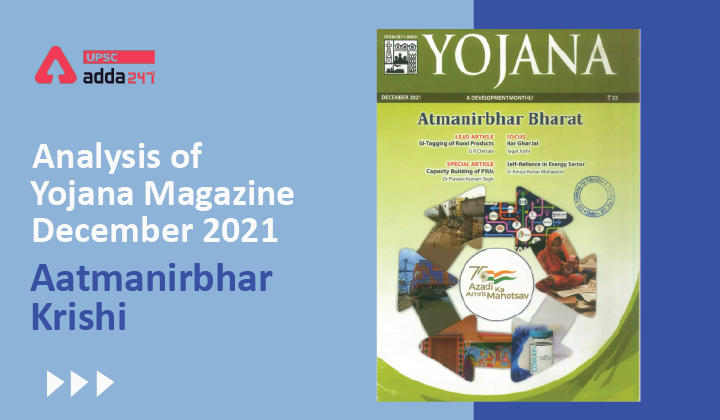Table of Contents
Introduction
- The Indian agricultural sector is largely production-oriented and plays a pivotal role in the Indian economy.
- About 55% of the total workforce of the country is still engaged in agriculture and allied sector activities, contributing about 18% to the country’s Gross Value Added (GVA) for the year 2019-20.
- Despite the pandemic-led contraction in other sectors, the agriculture and allied sectors have shown a robust growth rate of 3.4% at constant prices during the year 2020-21.
- The Gross Capital Formation (GCF)in agriculture and allied sectors relative to GVA in this sector has been showing a fluctuating trend between the years 2013-2017 but consistently rising from the year 2017-18 to 2079-20.
- Consumer spending in India is also expanding in 2021 post the pandemic-led contraction.
The Increase in Agri Export is a positive step towards Aatmanirbhar Krishi
- In a major boost to export prospects of agricultural produce, India registered a significant surge in export of agricultural and processed food products in the April-October period of the current Financial Year, 2021-22, in comparison to the corresponding seven month period of last fiscal, 2020-21.
- According to the Quick Estimates released by the Directorate General of Commercial Intelligence and Statistics (DGCI&S), the overall export of Agricultural and Processed Food Products Export Development Authority (APEDA) products witnessed 14.7 per cent growth in terms of USD during April-October 2021 over the same period of the previous year.
- This rise in exports has been achieved notwithstanding Covid-19 restrictions. The significant jump in exports of agricultural and processed food products during the first seven months of the current fiscal is in continuation of growth in exports witnessed in the financial year 2020
Role of APEDA in increasing Export
- The initiatives taken by APEDA, which functions under the Ministry of Commerce, has helped the country achieve this milestone at a time when most of the business activities suffered a huge setback due to the restrictions imposed after the outbreak of the second wave of the pandemic.
- The APEDA has also taken several initiatives to promote products having registered geographical indications (GI) in India by organising virtual Buyer Seller Meets on agricultural and food products with UAE and on GI products, including handicrafts with the USA.
- APEDA is continuing with the initiative of conducting Virtual Buyer Seller Meets (VBSM) with potential importing Countries to popu1arise the GI products of major agricultural commodities exported.
- In order to ensure seamless quality certification of products to be exported, APEDA has recognised 220 labs across India to provide services of testing to a wide range of products and exporters.
- APEDA also assists in the up-gradation and strengthening of recognised laboratories for export testing and residue monitoring plans.
- APEDA also provides assistance under the financial assistance schemes of infrastructure development, quality improvement and market development for boosting export.
- It also initiates the registration of pack-houses for horticulture products for meeting the quality requirements of the international market. Registration of exports units for peanut shelling and grading and processing units, for instance isto ensure quality adherence for the EU and non-EU countries.
- APEDA carries out registration of meat processing plants and abattoirs for ensuring compliance with the global food safety and quality requirements. Another key initiative includes the development and implementation of traceability systems that ensure the food safety and quality compliances of the importing countries.
About APEDA
The Agricultural and Processed Food Products Export Development Authority (APEDA) was established by the Government of India under the Agricultural and Processed Food Products Export Development Authority Act passed by the Parliament in December 1985.
How to overcome Agrarian Distress?
- The low per capita income of farmers – especially small and marginal farmers – is a major reason for agrarian distress.
Doubling of farmer’s income needs intervention at every node of the value chain. - Right from increasing the Total Factor Productivity and increasing the cropping intensity to diversification towards high-value crops and improving the terms of trade for the farmers are a must to cumulatively achieve the desired goal.
- The starting point of growth starts from making the quality inputs to farming, namely quality seeds, fertilisers, water, and power more accessible and affordable.
- The CSOs (NGOs, cooperatives, FPOs, and SHGs) need to scale up support to the farmers by providing knowledge dissemination, training, and capacity building services across the pre-harvest and post-harvest phases.
- Integrating agricultural frontier changes to precision fanning and crop diversification help fanners optimise costs and increase revenues respectively.
- A bulk of income growth can be achieved by better price realisation and efficient post-harvest management.
- Minimising the post-harvest losses through value-added products and an efficient value chain can prevent distress sale of the produce benefitting the fanners with returns ranging from 1.4-2.5 times.
- Access to distant and emerging markets through effective marketing and supply chain initiatives like e-NAM, contract fanning can aid the fanners in generating 2 to 3 times returns with higher bargaining power and minimise the price volatility.
- Through knowledge-based inputs, informed decisions can be taken up by the fanners to implement various scientific methods at the farm level, and by adopting effective post-harvest management techniques, fanners can upscale the productivity and develop new integrated fanning approaches while doubling their income.



 TSPSC Group 1 Question Paper 2024, Downl...
TSPSC Group 1 Question Paper 2024, Downl...
 TSPSC Group 1 Answer key 2024 Out, Downl...
TSPSC Group 1 Answer key 2024 Out, Downl...
 UPSC Prelims 2024 Question Paper, Downlo...
UPSC Prelims 2024 Question Paper, Downlo...
